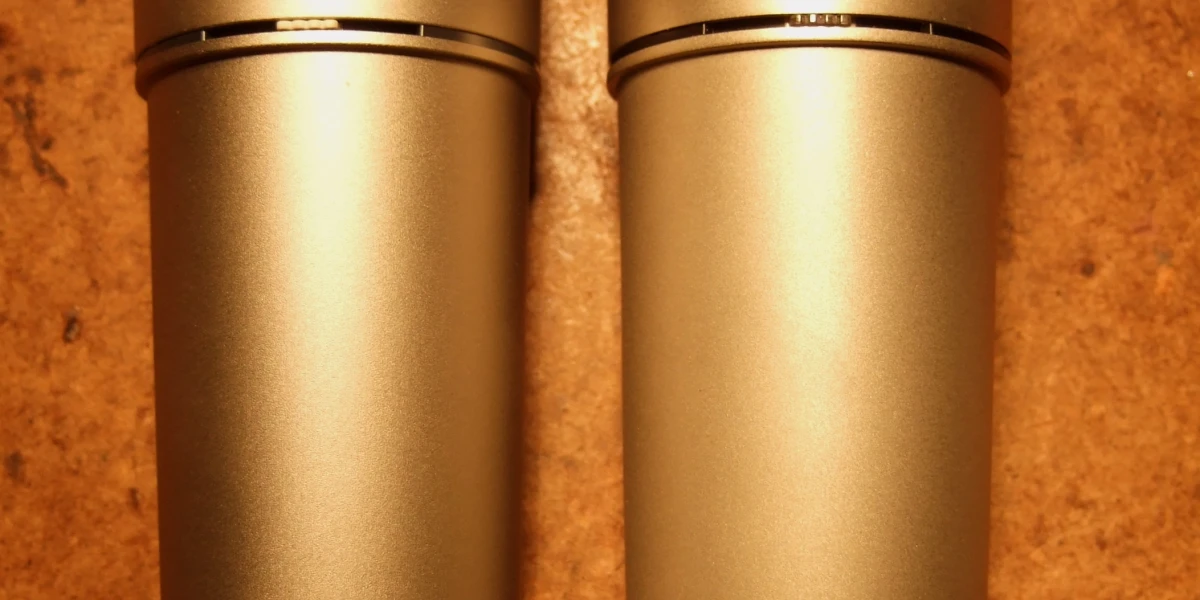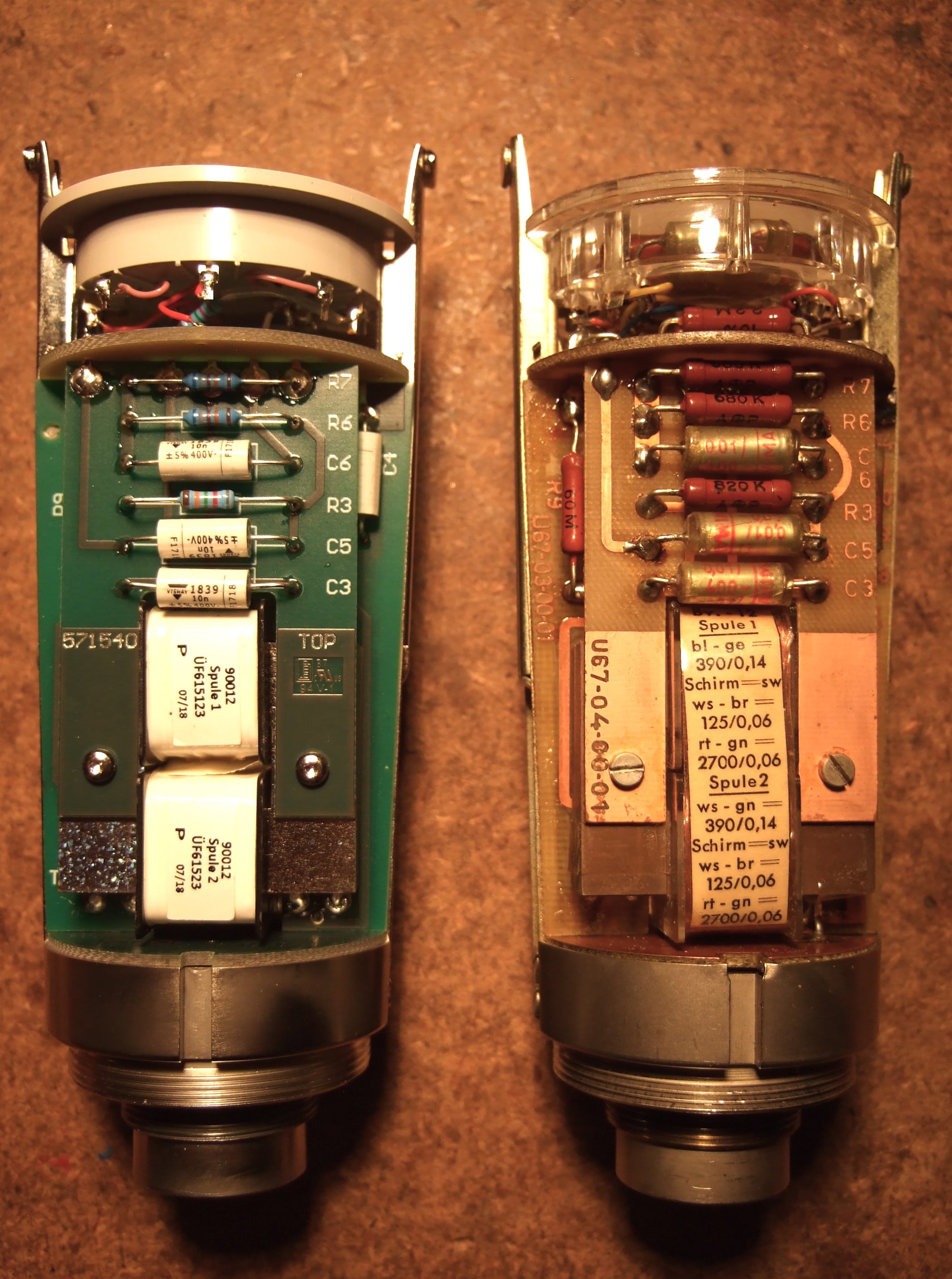Neumann U67 Reissue: Complete Tear Down and Analysis
In the spring of 2018, Neumann reissued the U67, a three-pattern, large diaphragm tube microphone first introduced in 1960.
To simply review build features, response curves, and component quality of the Reissue, in order to determine how faithful it is to the original, would be pointless. I’ve invested much of my adult life chasing after good sounds in microphones, therefore I put much emphasis in evaluating the Reissue with my ears, my senses, and the response from my pleasure center.
Unlike the original U67, the new Reissue does not touch that pleasure center, at least not out of the box.
My impressions and opinions will inevitably clash with those who bought the mic and hear (and feel) differently. But reports from happy U67 Reissue customers should not be discounted as less credible or erroneous. (I will address the seeming contradiction.)
With access to fine examples of original U67, and having restored and optimized close to a hundred of them over the years, I have a pretty good idea of the performance range of a well-working U67- what it is capable of, and why it became an icon.
The 9dB high-frequency emphasis of the dual-backplate K67 capsule with its phase-inducing offset ports, and its low-frequency proximity effect have been elegantly tamed through a combination of transformer feedback, feed- forward and shunt capacitors in the amp; the 4dB drop@16kHz prevents an overly thinned-out top; the U67’s mid range ranks among the most authoritative of any mics ever made, and the low end, while more choked than in the velvety M49 or the reedy U47, still has enough heft to convince as a mic of choice even for a bass-baritone.
With other words, the curtailments engineered into the U67 did not damage its sex appeal; using modest application of eq, engineers have learned to compensate for these limitations.
But the complex sound processing in the U67 is balancing on a precariously narrow ridge. And when the design or its execution is even moderately off, the whole structure collapses into a mediocre-sounding end result.
This was the case with a brand-new Reissue U67 #712xx I was able to test for several weeks, courtesy of Keith Banning who operates Grange Recorders in Sisters, Oregon: the mic sounded lifeless in the highs, choked and hard in the midrange, congested and unable to process complex information in time, resulting in sibilance. The bass region was starved, with the lowest octave severely under-represented.
The Gestalt of the Reissue (the sound stage) was oddly anemic and small, compared to the original. So, to me, the mic lacked sensual excitement, with an overall character best described as pedestrian, and only the faintest hint that this was the tube mic from the distinguished House of Neumann meant to revive the aura of one of the Big Five.
With access to quite a few excellent examples of original U67, their cables, NU67 supplies and NOS tubes from a variety of manufacturers, I was intrigued and committed to finding out where the bottleneck was that prevented this mic from pushing through to the lofty reaches of the original. Substituting one Reissue component at a time, I found the culprit(s), and was eventually able to get the Reissue to sound exactly like some of the best vintage originals. No, this is not a pitch to buy my services; you too can have at it, at reasonable cost, and without a technician’s involvement.
I already had an idea where the Reissue’s shortcomings might lie. I had read impressions by new owners online, most of which characterized the mic’s sound in more forgiving terms than I would- that it had a “modern” sound (whatever that means), was bright, pointy, midrange aggressive, and lacked low-end and warmth. But there were also some reports of owners who compared the Reissue to the vintage original, and found absolutely no difference.
What could account for these contradictory opinions? First, let’s take a closer look and dissect the beast.
Visual Inspection
On all pictures with two items, the Reissue is always shown on the left. Click on any picture to enlarge it.
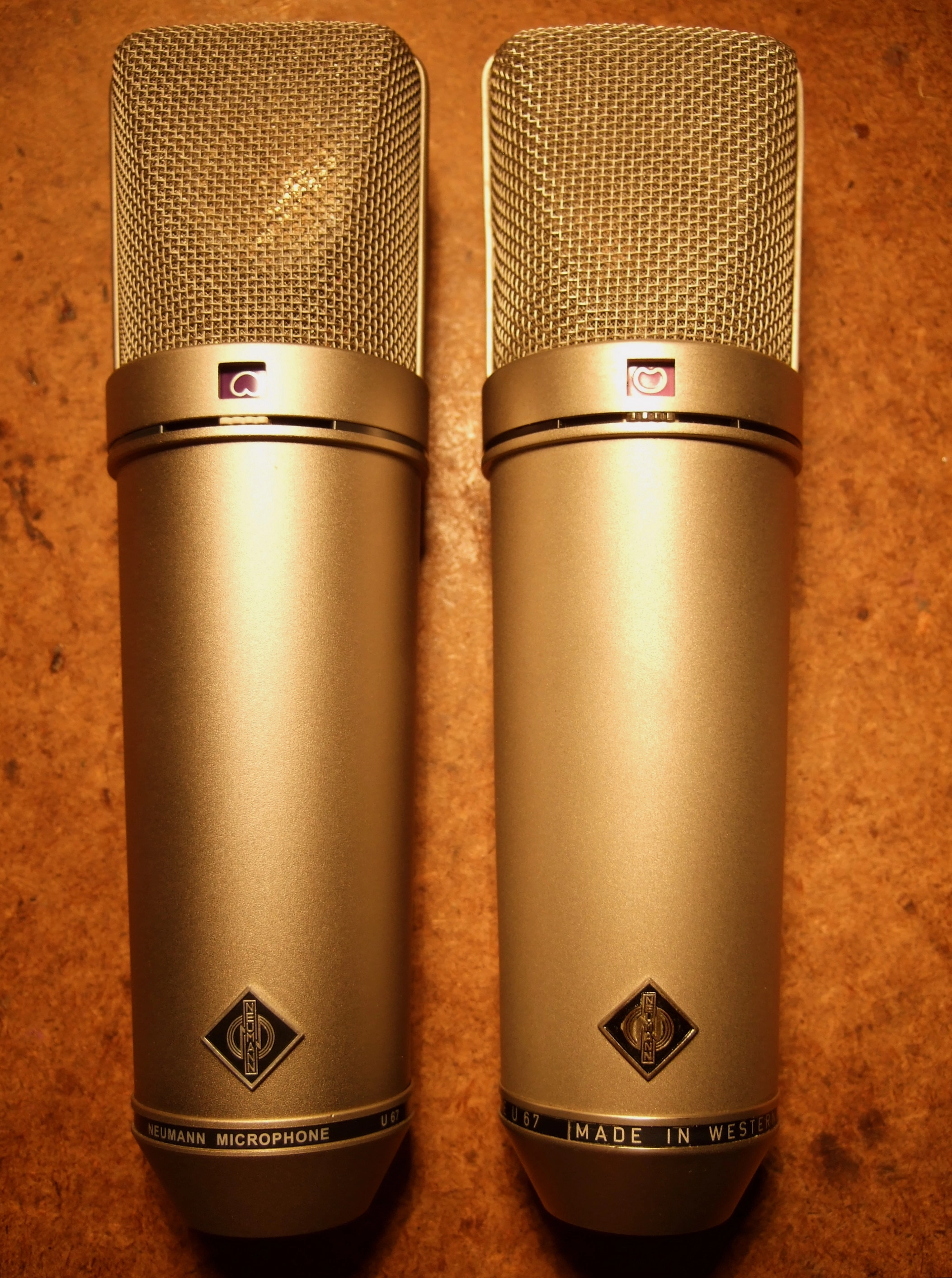

The complete head - K870/67 capsule, mount, grill, and switch assembly - is the same as used on the current U87Ai, except the safety key (a slotted stalk acting as third head screw that fits into a hole in the amp’s head) is replaced with a regular slot screw as found on the U67 and older U87. (U87Ai head assembly pictured on right)

Side note: You can readily swap head baskets, bottom bells, frame supports, and housing tubes between any U67, M269, U87, and U87Ai without modification; but you cannot replace a defective pattern or attenuation switch on an original U67 with one from the Reissue. The new switches connect via magnetic reed, not mechanical pressure.
As with current U87Ai, the surface sheen of the Reissue’s housing components is slightly courser and shinier than the originals were. The Reissue’s badge is black, indicating it’s a tube Neumann, and the decal on the bell identifies the model and its recommended supply.
Electronic component layout on the four amp boards is pretty much duplicated from the original U67.
Capacitor and resistor values and positioning also seem identical with the 1960s version.
Side note: Original and Reissue come stock with low-cut wire switch S2 on the amp connected. That cuts bass response (capsule included) a max. of 6dB @ 40Hz. The price for low-end eq in mics and elsewhere is phase anomalies and other artifacts. Proximity and room issues should therefore be mitigated at the source. The U67 processor retains best low-end fidelity with S2 open. All listening tests were done with S2 open.
Capsule
For the Reissue, Neumann uses stock K870 capsules found in current products U87Ai, TLM67 and USM69. In the Reissue, the capsule sits 6mm higher in the basket than in the original.

As I found out during listening tests, these capsules are not tweaked or especially selected for one of the most expensive mics in Neumann’s line- up. Contrary to common assumption, front sides are also not selected or marked. Neumann believes that any capsule whose response falls within a pre-determined tolerance range will be good enough for installation in any mic.
Tube
One significant factor that can contributes to the sound quality of tube audio processors is the quality of tubes. And nowhere is that more apparent than with tubes used in microphones; their unique impedance-converting task puts a strong magnifying glass on quality.
Since the demise of U.S. and European tube factories, Russia, Slovakia, and China are the only current suppliers of microphone tubes. When comparing historic quality standards from manufacturers who had their tube chemistry and metallurgy down, all modern tubes suck. It’s beyond this article’s scope to explain the technical reasons why modern miniature triodes and pentodes sound inferior in high-end mics, and most of them don’t last long.
Judging from the choice used in the Reissue - a short-plate Russian EF86, re-branded by New Sensor as Tung-Sol EF806SC* this tube behaved flawlessly under stress: I ran it in the mic for three weeks straight, and it held up and stayed as quiet as the best NOS European EF86 versions. Neumann affixes a silver “select” banderole to pre-sorted tubes, including hand-written serial number.
*Tung-Sol, a long-defunct U.S. tube manufacturer, never made EF86 or EF 806S tubes. New Sensor Corp. acquired the rights to an illustrious brand name.

Lacking affordable high quality EF86 alternatives, there really was no other choice for a company like Neumann with a goal to revive a high-end tube mic and sell it in numbers, than to choose the best of the current Russian crop.
This then is the answer to the question most often brought up about current tube quality: Why don’t mic manufacturers use a better tube? To search the internet for NOS Amperex, Mullard, Telefunken, etc., paying several hundred dollars/per, then discard a good half or more that don’t hold up, would be a logistical and financial nightmare for any manufacturer. Such efforts are best transferred to discriminating mic owners with time and money to select and stock up on NOS.
Cable and Connectors
The company which makes the Reissue cable is not identified. Its rather small diameter looks familiar from cables supplied with M147 and M149. Termination and isolation of the ultra-thin conductors is flawless.

Neumann used Binder IP-40 connectors throughout. Since the demise of Tuchel, Binder is now the only choice for mic systems requiring 7-pin broadcast connectors, as used for Neumann’s M2xx mics.
To duplicate the original U67 pin orientation, and to avoid connecting to AC701-powered mics, the Binder connectors for the Reissue needed to be re-keyed: a new channel was cut at the pin #1 position, and the original channel between pins #6 and #1 was filled with epoxy (see picture). A bit primitive, but it works, and is hardly visible. (The original Tuchel-made U67 connector with its unique pin #1 key position mold, was mechanically and electrically superior, but has been obsolete for decades.)
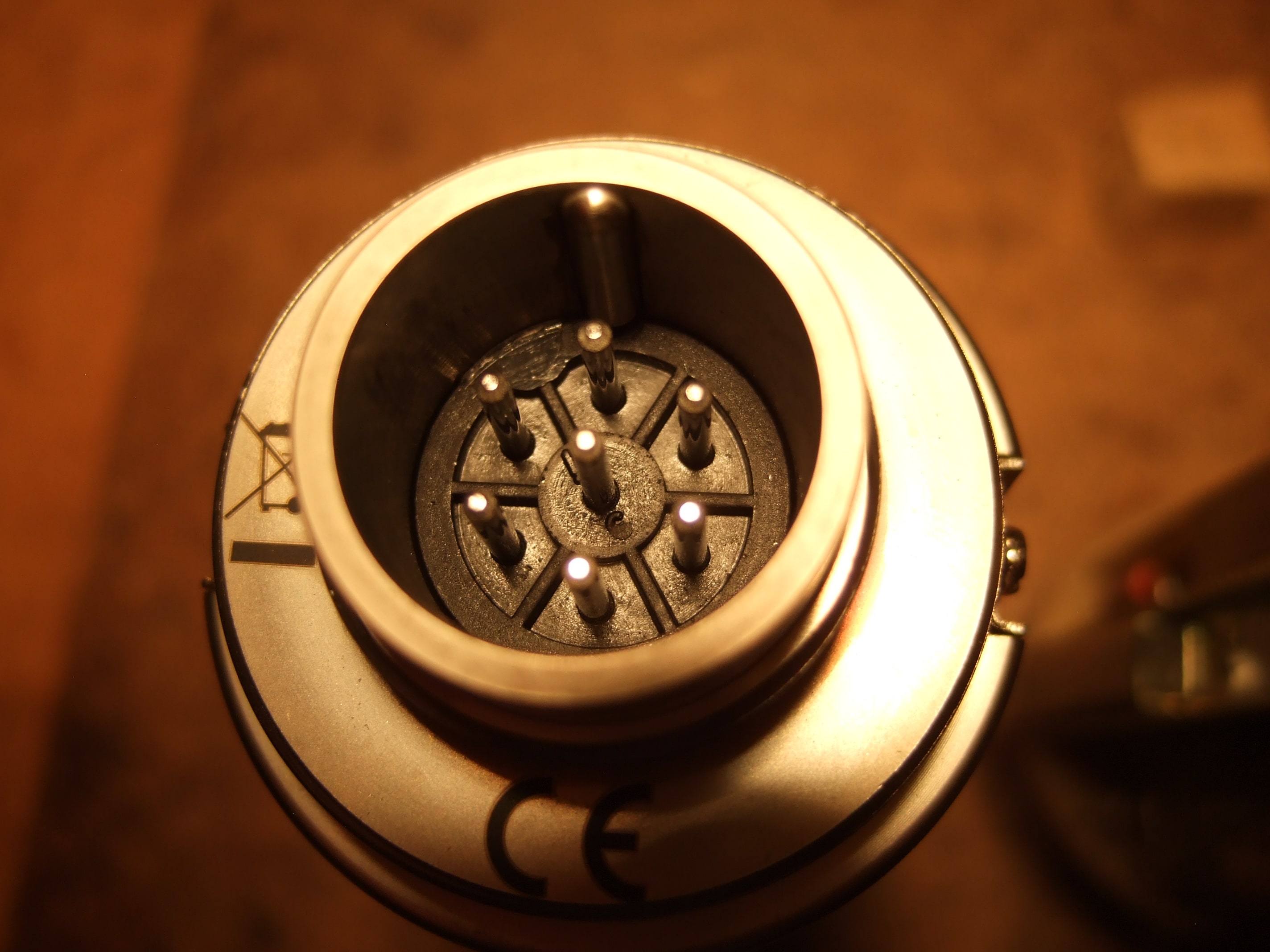
Power Supply
Lifting the lid from the Reissue NU67V, its high build quality is apparent: no more Chinese step-down transformers, as used in M147/149 supplies. Lid and frame are solid and heavy; component layout is meticulous.
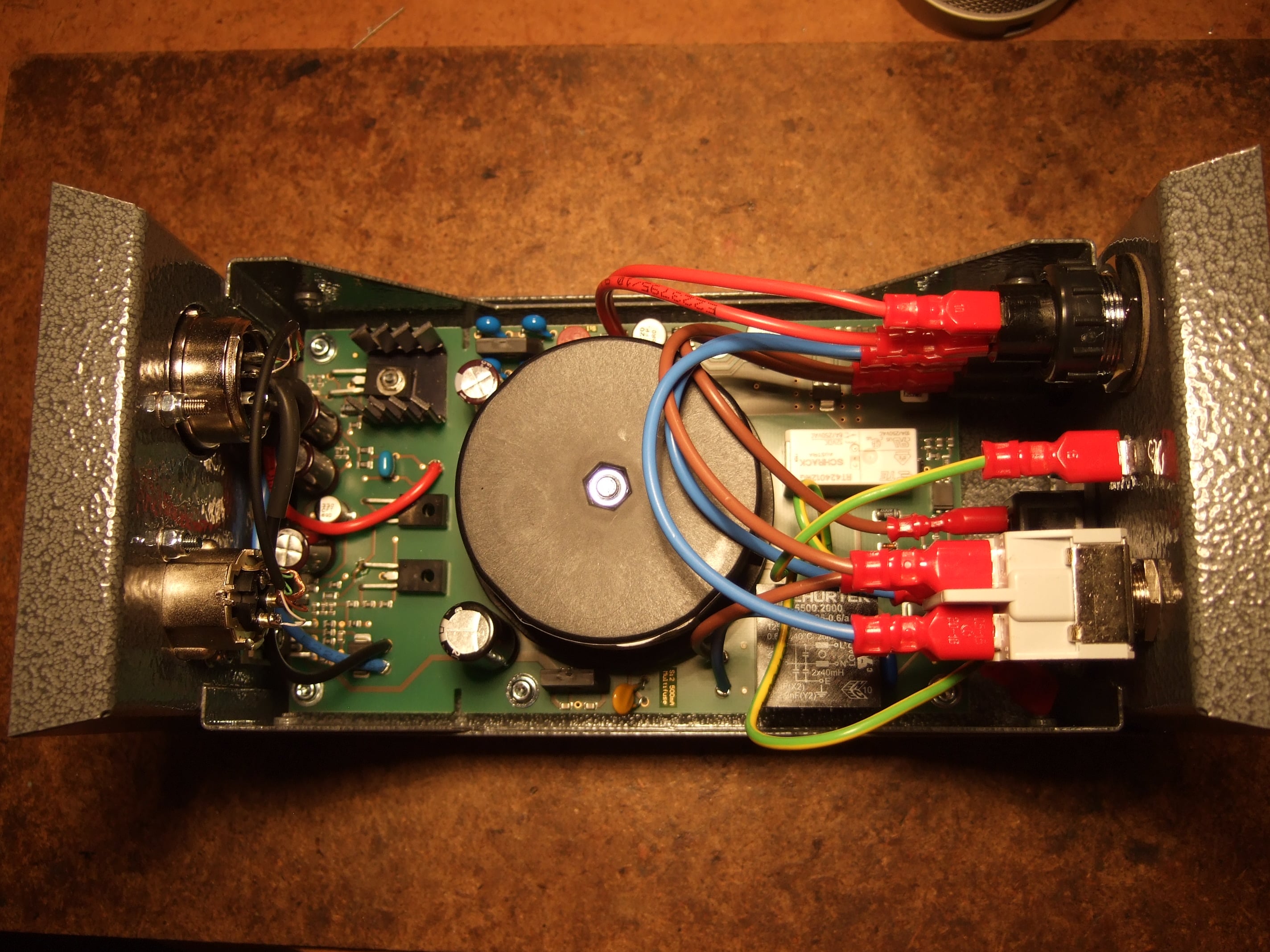
Wiring sizes are substantial and perfectly routed, with the exception of the anemic audio wiring between mic and XLR connectors.

Circuit board layout and labeling was done logically and intelligently.
It took some engineering brains to make this a “no adjustment option” supply, and still nail B+ and heater voltages, no matter the cable length or EF86-type used. I had never seen this before in a commercially available supply.
Listening Tests
Let’s investigate the sound of the Reissue, and whether it is comparable to that of the vintage original. And if not, what factors might stand in the way, and whether it would be possible to make the Reissue sound as good as a perfect vintage original.
In a high-end condenser mic, the effect of components that determine the quality of sound is cumulative; even a preponderance of well-selected components cannot overcome or neutralize the presence of even one badly chosen part: capsule, tube, transformer, passive components, circuit traces, wiring, mic cable, power supply... each will affect parameters like noise, frequency response, dynamic behavior, timbre, resolution and emotional attraction. (In my opinion, nothing short of a positive emotional response matters for a mic at that price.)
But when we substitute items that only have a subtle impact on a mic’s sound, like a cable or a power supply, we may not hear it in a system whose sound may be compromised elsewhere by more significant roadblocks, like a deficient capsule or tube.
Therefore, the better method of finding out what component of the Reissue has what influence on the sound, and how it may deviate from that of the original, I started out with a well-maintained, therefore representative, vintage U67, then gradually substituted one component after the next in the vintage system. This way, even a subtle deterioration of the mic’s character or sound, say, from the choice of cable, would show up.
And it did: removing one component after another from the characterful, highly authoritative vintage U67 I had selected as the ideal candidate for comparisons, and substituting these parts with ones from the Reissue eventually turned the original’s sound exactly into that of the Reissue. Replacing one original part after another from the vintage U67 to the Reissue confirmed the theory in reverse: after capsule, tube, cable, power supply were transferred into the Reissue, it sounded as elegant, emotionally attractive and musical as the original.
Here are the substitutions, in the order taken, from the most subtle to the most noticeable effect, and the options Reissue owners have if they want to make that mic as compelling sounding as a well-maintained vintage U67:
1. Reissue: NU67V Power Supply
Test: Vintage U67, Telefunken EF86 chrome plate, original cable, but replaced vintage NU67u (1963) power supply with Reissue NU67V (2018) power supply.
DC output @ 120VAC nominal: 207 B+, 6.3VDC Heater.
(These voltages are very close to ideal, considering that there are no adjustment options)
The Sound: against expectations* a small reduction in sound stage width; the formerly robust lower mids are affected and so is the dynamic behavior; everything sounds a bit smaller, slightly distant, a bit listless, with an onset of high-mid smear; a small but noticeable step down in resolution. It’s subtle, but I had no doubt after repeating the test 10 times over several days.
*confirmation bias? I was previously incredulous of the impact a power supply could have on a tube-condenser mic’s sound. I used to discount ‘Golden Ears’ who claimed to “hear the power supply”. No longer.
2. Reissue: Microphone Cable
Back to the all-original vintage U67/NU67u set-up, but tested three different cable types against the Reissue version.
With four cable choices, this test was more extensive than just A and B.
For the American market, Neumann supplied the vintage U67 with a Belden 3344 cable with traditional cross-braided shield and conductors with low strand-count.
Around 1964 the 3344 was replaced with a Dörfler-made cable with Reussen-shield (96-count conductor stranding, and two multi-stranded bare copper layers cork-screwed in opposite direction around the cable’s signal conductors).
I was also curious how a current-generation Gotham GAC7 (similar construction as Dörfler’s) would sound, as this option is used by high-end boutique mic manufacturers (I used it for the KHE).
The Sound:
a. Original Belden 3344 cable (ca. 1963): In a word, a match made in heaven. Despite its unsophisticated construction, there is magic and emotion and music: clear, yet richly textured, with fast mids, and excellent high frequency follow-through that never dominates. This is the cable that translates the U67‘s emotional power and connects best with the listener*
b. Doefler-made German Broadcast cable (ca. 1965): rich bass, authoritative lower mids, but with a slight, dark, not strident, sibilance; lacking in upper register clarity.
c. Gotham GAC 7 (from current production, after 2 week burn-in, terminated with NOS Tuchel broadcast connectors): tight bass, pleasant dry, woody low-mid reediness (a term I use for high resolution and speed in that range), and a sound signature similar to Gotham’s 3-conductor
GAC3. Sound with this cable was not strident or congested, but using it for the U67, I missed upper register follow-through and clarity. Disappointing, considering its excellence when matched with other high- end mics.
d. Reissue cable: good frequency balance, good bass, reasonably fast, a little bit of mid-range congestion, lacking the high-frequency thrill and dimensional expansion of the Belden. Coming in second best, that skinny cable is good enough to be used in a pinch even with a vintage U67, and is certainly the right choice for the Reissue, given that the Belden 3344 is no longer available, as far as I know.
* it’s worth pointing out that the response and dynamic behavior of a cable is not static or fixed, but audibly changes, depending on the mic (specifically its output transformer) it is connected to: a 4-conductor Belden 3344-style cable was supplied during the U47‘s final years by Neumann’s U.S. importer, but there, it was the wrong choice, sounding too hard and edgy, compared to the earlier “rubber hose” version.
3. Reissue Tung-Sol EF806SG Tube
Back to my all-original vintage U67/NU67u set-up, including original Belden cable, but replaced NOS Telefunken EF86 (chrome plate), with Reissue’s Russian “Tung-Sol EF806SG” tube.
The best way to describe the difference in sound of the Russian tube: Imagine you add a triple-layer pop screen between mic and sound source; everything sounds a bit more distant, slower, less lively, with a bit of mid- range congestion, and lack of an airy layer up top.
Side note: As much as I can rely on a Tele EF86 to deliver superb resolution, especially in the high frequencies, and to last forever, I am partial to the mid range texture and sex appeal of Amperex meshplate EF86. To me, that’s another match for the U67 made in heaven.
4. Reissue: K870/67 Capsule
Back to my all-original vintage U67/NU67u set-up, including original Belden cable, but replaced original K67 capsule with Reissue K67/870.
The compromised K67/870 capsule is easily the biggest obstacle to good sound in the Reissue I tested. Many owners of U87Ai (same capsule) made after 2000 have complained about stridency, sibilance, and lack of full bottom in their mics. I have written about my own dissatisfaction with these capsules since the early 2000s on my forum and others. While the design dimensions are unchanged since 1960, (with minor substitutions of materials), the diaphragm tension is now too high on too many of them, and this certainly was the case in the Reissue K67/870 I tested.
The sound of this capsule can only be described as ugly; and none of the vintage mic’s excellence of circuitry, tube, cable, power supply, etc. could overcome such severe bottleneck at the entrance to the conversion and processing of acoustic energy.
Mid-heavy to the point of pinched, hyper sibilant, choked in the bass, lacking any smooth transition between mids and highs - all because the mids are so dominant and harsh due to the stiff membrane* which chokes off any subtlety.
Initial impressions were confirmed when I removed that capsule and installed several K870 from a few new U87Ai I had available. They all sounded different, but most trended in the direction of the pinched, honky mid-dominance of the capsule that came in the Reissue.
* How do I know it’s too much diaphragm tension that causes all this trouble? Because eventually I “relaxed” the honky K67/870 installed in the Reissue, as I had done with several recent U87Ai capsules, and it ended up with full bass, frequency balance, and similar timbre as the K67 from the vintage mic.
But to demonstrate how unpredictable Neumann’s capsule manufacturing has become: Among the ten capsules I tested for this occasion (actually: twenty sides, as no two sides ever sound the same, with some sides deviating significantly from each other) were two never-used K67/870 extracted from virgin 2008 TLM67. These sounded every bit as sexy, frequency-balanced and robust in the bass as the original brass-ring K67 from the vintage U67 I used throughout these tests.
This, then explains the contradictory reports from new owners of Reissue 67: some obviously got lucky with balanced capsules, others not so much.
5. Reissue: Complete Circuitry
Rather than picking off each resistor, capacitor, or the transformer from the Reissue at a time, and soldering these components one by one onto the original board, I conducted a reverse test to determine whether any of these components had any audible effect at all: equipping the Reissue with the capsule, tube, cable, and power supply from the original, and all at once, I could not hear the slightest difference between that assembly and the original vintage U67 system. That meant that the Reissue’s passive components, wiring and circuit traces were of high enough quality to be interchangeable with those on the original U67, with no cumulative or ill effect.
Because the mic amp (tube aside) had zero influence on the sound, by deduction, the transformer choice in the Reissue could not be detrimental to the sound of the mic, but must be of the same high quality and characteristic timbre as the original BV12.
Five Final Take-Aways.
One.
If you disagree with my methodology or assessment, please forgive me. I listen to and evaluate the sound of high-end microphones on an emotional level, first and foremost. I am experienced in analyzing, judging, and tuning microphones that way, and as long as enough people continue to agree with my assessments, I am confident with that approach professionally. But it’s naturally subjective. You think differently? Fine, let’s leave it at that.
Two.
By far the biggest audible difference between Reissue and Vintage is the capsule. But as I reported, it’s not as straight forward as simply replacing the current one with, say, an exquisite one from a vintage U67. As with current K870, some, but not many, capsules installed in Reissues will be perfectly frequency balanced, with good low end, and little congestion or sibilance. I attribute the glowing reports from some owners to the presence of a well-rounded capsule in their Reissue. This was not the case with the one I had for testing. It was just awful. I ended up installing the K67 from the TLM67 for the owner. It sounded glorious.
Three.
Capsule substitution or re-tuning will get you far. Far enough and good enough for many owners, I suspect. But if you want to get the exact same ultra-high level of performance of a fine vintage U67 from the Reissue, you need to do all of the following:
* replace or modify the capsule, to add highs, reduce sibilance and mid-range congestion, improve low-mid texture and low frequency extension
* replace the Russian tube with a well-selected European old stock Telefunken, Amperex, Valvo, Mullard or similar EF86, to improve fidelity and resolution. OLD stock is the key. No currently-manufactured EF86/806 are any good if you want three-dimension-like resolution
* replace the power supply with an original NU67 or any intelligently-designed modern type, to improve dynamic behavior and fidelity
* replace the stock cable with a Belden 3344 for its unique sex appeal and high frequency clarity
Addressing these items in a Reissue U67 will cost less than $2000 in 2018 dollars. After that investment, you would then have a microphone with the exact same sound signature of a superb-sounding vintage U67.
Four.
I had mentioned that it is sometimes hard to distinguish between slightly
better or worse components in a microphone system when you have more significant sonic bottlenecks to contend with. An analogy: when vision is obliterated by heavy fog, you just can’t see whether a layer had just lifted in the distance.
And so it was with the power supply and cable tests: Differences between vintage and Reissue components did not show up at all when substituting these items in the Reissue mic system, because stronger layers of obstruction (capsule, tube) stood in the way to detecting minor ones.
If someone insisted on how much I thought each component was responsible for the Reissue’s compromised sound, I’d assign 70% to the capsule, 20% to the tube and 5% each to cable and power supply. That means, replacing capsule and tube will go very far towards a sensually satisfying U67 Reissue.
I realize, assigning percentages to auditory impressions is unscientific and ridiculous. I am open to a better scaling or weighing method.
Five.
I debated whether or not to publish my impressions of the Reissue U67. My history of support for all things Neumann is long. I ended up in this profession because of my admiration for Neumann’s passion for excellence. And I am impressed that the folks in Berlin try hard to continue Neumann’s heritage under a corporate ownership which would have sent any other legacy mic manufacturer into oblivion or irrelevance.
Though the Reissue U67 is for me a mixed bag, it would be unrealistic to expect much more: nobody makes decent tubes suitable for high-end mics; reviving the historic power supply would have been impossible under current safety and material codes; and choosing a tube mic cable remains too much art than could be guided by science alone.
That leaves the capsule. Put simply: Neumann would make many owners of U67, U87Ai and TLM67 mics very happy if they would relax the capsule’s diaphragm tension to its former range, without the need to change anything else on this legacy product. Why they don’t do it, I can only speculate.
Neumann knows of my concerns. A few years ago, I had sent them two factory-fresh capsules, one from the pre-2000, frequency-balanced era, the other one from the newer crop of bass-starved K870. They ran thorough tests (they sent me the results) and, though the graphs clearly show a bass-roll off of several dB on the bass-starved capsule, Neumann deemed both versions to be within spec.
